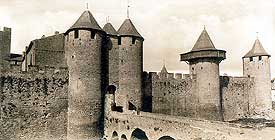 |
|
The castle after the restoration
of its east entrance
|
|
 |
|
The castle surroundings,
and barbican. Restoration plan.
|
|
|
AFTER THE DEATH OF VIOLLET-LE-DUC :
PAUL BOESWILLWALD
|
| |
  ollowing
the death of Viollet-le-Duc in 1879, his assistant and project
inspector, Guiraud Cals, briefly assumed responsibility for
the site. In this letter to the Fine Arts minister, he paid
moving homage to his master: ollowing
the death of Viollet-le-Duc in 1879, his assistant and project
inspector, Guiraud Cals, briefly assumed responsibility for
the site. In this letter to the Fine Arts minister, he paid
moving homage to his master:
"The death of M. Viollet-le-Duc is a very great loss to me; I have worked under him since 1848; I loved him because he was kind and strict at the same time; my father worked under him before me, from 1845 till 1848."
From 1880, Paul Boeswillwald, an ex-student of Viollet-le-Duc
continued and finished the restoration of the ancient fortified
town, scrupulously following the architect's plans. His most
significant project was the work on the castle and its barbican
which began in 1890 and marked the end of the restoration of
the fortress when it was finished in 1910. Paul Boeswillwald
put the finishing touches to the Carcassonne site by reconstructing
on one of the castle
curtain wall
the wooden hoardings
the principle of which Viollet-le-Duc had redefined earlier.
In the space of 60 years, the city, which had come under the
administration of the Ministère des Beaux-Arts (Fine Arts ministry)
in 1903, had undergone a radical transformation. The lists
cleared of the houses that had hidden their walls, the defensive
walls with their new battlements
the towers with their slate roofs, gave the Carcassonne fortress
back its medieval appearance.
|
 |
| Main entrance to the Count's Castle. 1910. |
|
 |
| |
The Count's Castle, west
facade before restoration.
Viollet-le-Duc, drawing. |
| |
 |
| |
View of the Count's Castle
from the south.
Viollet-le-Duc, drawing |
| |
 |
|













 ollowing
the death of Viollet-le-Duc in 1879, his assistant and project
inspector, Guiraud Cals, briefly assumed responsibility for
the site. In this letter to the Fine Arts minister, he paid
moving homage to his master:
ollowing
the death of Viollet-le-Duc in 1879, his assistant and project
inspector, Guiraud Cals, briefly assumed responsibility for
the site. In this letter to the Fine Arts minister, he paid
moving homage to his master:








